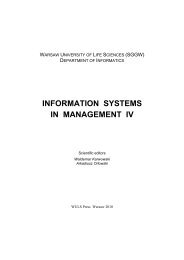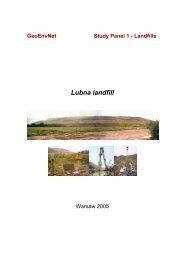ACTA SCIENTIARUM POLONORUM - SGGW
ACTA SCIENTIARUM POLONORUM - SGGW
ACTA SCIENTIARUM POLONORUM - SGGW
You also want an ePaper? Increase the reach of your titles
YUMPU automatically turns print PDFs into web optimized ePapers that Google loves.
Business demography issues and empirical research on dynamics of enterprises’... 79In the Business Demography Project, NACE Code was used to define the range ofbasic indicators in calculations. Business economy covers sections C–K and M–O. Data onagriculture, hunting, forestry, fishing, public administration, households with employees,exterritorial organizations, and management activities of holding companies is not collected.Aggregations were done on business economy to: industry (sections C-E) construction(section F) and services (section G–K) and other services (M–O) [Hult M. 2003, p. 7].Birth (European Commission, Regulation no 2700/98) (all definitions follow ECpublications, Eurostat-OECD, 2007) – the creation of a combination of productionfactors with the restriction that no other enterprises are involved in the event. Births donot include entries into the population due to mergers, break-ups, split-off or restructuringof a set of enterprises. Births do not include entries into a sub-population resulting onlyfrom a change of activity. If a dormant unit is reactivated within two years, this event isnot considered a birth.Birth rate – number of enterprise births in the reference period t divided by thenumber of enterprises active in t.Death (European Commission, Regulation no 2700/98) – the dissolution of a combinationof production factors with the restriction that no other enterprises are involvedin the event. Deaths do not include exits from the population due to mergers, take-overs,break-ups or restructuring of a set of enterprises. Deaths do not include exits from a subpopulationresulting only from a change of activity. An enterprise is included in theamount of deaths only if it is not reactivated within two years.Death rate – number of enterprise deaths in the reference period t divided by thenumber of enterprises active in t.Active enterprise – enterprise that had a turnover or employment in any time duringthe reference period even in limited time. If no information is available to define the activeenterprise, the local country-specific methods are used. Number of active enterprisesduring reference period is defined as „population of active enterprises”.Survival – is defined as the continuity of an enterprise over time. Thus an enterprisehas survived from year t to year t + x if it is still active in year t + x, even if it had a changeof ownership.Survival rate – the number of enterprises in the reference period (t) newly born int–x having survived to year t divided by the number of enterprise births in t–x. In the caseof a 2-year survival rate x = 2, in the case of a 5-year survival rate x = 5.Statistical unit – enterprise – is defined in Council Regulation (EEC no 696/93 of15 March 1993) – as the smallest combination of legal units that is an organizational unitproducing goods or services, which benefits from a certain degree of autonomy in decision-making,especially for the allocation of its current resources.NACE – hierarchical classification of economic activities (Hult, 2003, and Businessdemography in Europe. Results for 10 member states and Norway. Data 1997–2001, (EC,p. 134), including four levels of economic activities classification:Level 1 (Section) alphabetical code.Mid Level (Subsection) two-character alphabetical code.Level 2 (Division) two-digit numerical code.Level 3 (Group) three-digit numerical code.Level 4 (Class) four-digit numerical code.Oeconomia 10 (1) 2011
















